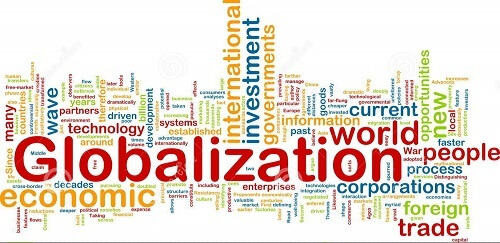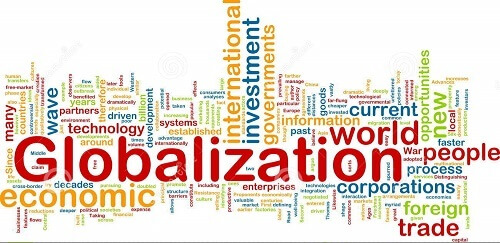Table of Contents
GLOBALISATION AND INDIAN ECONOMY CLASS 10 CBSE CBSE
DOWNLOAD MOBILE APPLICATION TO LEARN MORE: GLOBALISATION AND INDIAN ECONOMY CLASS 10 CBSE

NCERT QUESTIONS
1.What do you understand by globalisation? Explain in your own words.
Ans. Globalisation refers to the process of integration of economies of the world under conditions of free flow of trade, capital and movement of persons across borders. In this process, goods and services are produced and marketed throughout the world. Under this, the companies set up their production units or branches in more than one country for its operations.
It includes:
(a)Increase in foreign trade.
(b)Import and export of techniques of production.
(c)Flow of capital from one country to another.
(d)Migration of people from one country to another.
2.What were the reasons for putting barriers to foreign trade and foreign investment by the Indian government? Why did it wish to remove these barriers?
Ans. The Indian government put barriers to foreign trade and A foreign investment to protect the domestic producers from foreign competition, especially when industries had just begun to come up in 1950s and 1960s. At this time, competition from imports would have been a death blow to growing industries. Hence, India allowed imports of only essential goods.
In 1991, the government wished to remove these barriers because it felt that domestic producers were ready to compete with foreign industries. It S felt that foreign competition would improve the quality of goods produced by Indian industries. This decision was also supported by powerful international organisations. This marked the beginning of the New Economic Policy in India.
3.How would flexibility in labour laws help companies?
Ans. Flexibility in labour laws will help companies in being competitive and progressive. By easing labour laws, company heads can negotiate wages and terminate employee, depending on market conditions. It will also help the companies to carry its operations with the skilled and experienced workers and reduce the cost of production.
4.What are the various ways in which MNCs set up or control production in other countries?
Ans. Multinational Corporations (MNCs) set up their factories or production units close to markets where they can get desired type of skilled or unskilled labour at low costs along with other factors of production. After ensuring these conditions, MNCs set up production units in the following ways:
(a)They operate jointly with some local companies of the existing country.
(b)They set up their own production units in a new country.
(c)They buy the local companies and expand their production with the help of modern technology and investment.
(d)They place orders for production with small producers and sell their products under their own brand name to the customers worldwide.
DOWNLOAD MOBILE APPLICATION TO LEARN MORE: GOBALISATION AND INDIAN ECONOMY CLASS 10 CBSE
5.Why do developed countries want developing countries to liberalise their trade and investment? What do you think should the developing countries demand in return?
Ans. Developed countries with the help of latest technology have surplus production and for this, they require market to sell their products. Developing countries provide favourable conditions for the developed countries either in the form of market or centres of production. Therefore, developed countries want developing countries to liberalise their trade and investment so that the MNCs can set up factories in less expensive developing nations, and thereby increase their profits, at lower manufacturing costs. The developing nations should demand for fair trade practices to be followed by the developed nations under which they should stop giving subsidies to their agricultural sector. Unfair trade barriers should be removed.
6.”The impact of globalisation has not been uniform.” Explain this statement.
Ans. Since its introduction, globalisation of Indian economy has come a long way. Now, there is greater choice before consumers available at lower prices for several products. People are enjoying much higher standards of living than in earlier times. Local companies supplying raw material etc. to MNCs have prospered. Production standards have been raised
But the other side of the picture is not very bright. Flexibility in labour laws has worsened the conditions of workers because they are appointed on non-regular basis to avoid facilities such as provident fund, gratuity etc. Job opportunities have increased only for skilled and educated people. Only a few companies have successfully made collaborations with foreign companies or emerged as multinationals. There are a number of industries such as toys, tyres, batteries, plastics etc. where the small manufacturers have been hit hard due to stiff foreign competition. Thus, we can say that the impact of globalisation has not been uniform.
DOWNLOAD MOBILE APPLICATION TO LEARN MORE: GLOBALISATION AND INDIAN ECONOMY CLASS 10 CBSE
7.How has liberalisation of trade and investment policies helped the globalisation process?
Ans. Liberalisation of trade and investment policies have made foreign trade an investment easier. Earlier, several developing countries had placed barriers and restrictions on imports and investments from abroad to protect domestic production. However, to improve the quality of domestic goods, these countries have removed the barriers. Thus, liberalisation has led to a further spread of globalisation, because now business houses are allowed to make their own decisions on imports and exports. This has led to a deeper integration of national economies into one conglomerate whole.
8.How does foreign trade lead to integration of markets across countries? Explain with an example other than those given here.
Ans.Foreign trade provides opportunities for both producers and buyers to reach beyond the markets of their own countries. Goods travel from one country to another. Competition among producers of various countries as well as buyers prevails. Thus, foreign trade leads to integration of markets across countries.
For example, during Diwali season, buyers India have the option of choosing between Indian and Chinese decorative lights and bulbs. So, this provides an opportunity to expand business.
9.Globalisation will continue in the future. Can you imagine what the world would be like twenty years from now? Give reason for your answer.
Ans. After twenty years, there are possibilities that there would be positive changes in the process of globalization. There would be healthy competition, improved productive efficiency, increased output, fair distribution of income, more employment opportunities, better living standards, more access to information and modern technology. The following are the reasons in its support.
(a)Increase in the number of countries supporting the demand for fair rules in international trade keeping in mind the needs and situation of the developing countries.
(b)Increased availability of qualitative and quantitative human resources due to greater access to education.
(c)Increased resource and industrial base in major countries due to establishment of production units.
(d)Growth of young entrepreneurship.
DOWNLOAD MOBILE APPLICATION TO LEARN MORE: GOBALISATION AND INDIAN ECONOMY CLASS 10 CBSE
10.Supposing you find two people arguing: One is saying globalisation has hurt our country’s development. The other is telling, globalisation is helping India develop. How would you respond to these arguments?
Ans. My view is that globalisation has helped India to develop. For this, the reasons are:
(a)MNCs are making investments in India in different sectors such as insurance, banking and food processing units.
(b)People have wider choices to make.
(c)Standard of living of people has increased. (d) Increase in the volume of trade in goods and services.
(d)Inflow of private foreign capital and export orientation of the economy.
(e)More availability of investible funds in the form of FDI.
(f)Helps in development and strengthening of domestic economy of India.
(g)Improved productive efficiency and healthy competition.
(h)Increase in volume of output, income and employment.
DOWNLOAD MOBILE APPLICATION TO LEARN MORE: GLOBALISATION AND INDIAN ECONOMY CLASS 10 CBSE

